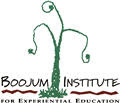Friday, April 22, 2011
Thank you Russell Apiaries!
The Boojum Institute for Experiential Education would like to give Russell Apiaries a huge THANKS for donating three queen bees for our splits. Your generous contribution helps keep our Honeybee and World Health program going, ensuring that students learn crucial science concepts through a hands on experience with live bees!
Friday, April 15, 2011
The Boojum Beeyard: Splitting Colonies
The early blooms of spring color the landscape and our two colonies are booming. The first Honeybee and World Health classroom presentations of the year are already scheduled and we need to get the observation hive ready to travel. The colonies seem healthy enough to do some splits.
The existing hives are smoked and opened up. We have two hive boxes with some empty frames ready nearby.
We find frames with bees, brood, and food stores and place them into the empty hive boxes. We have also placed a frame feeder in the deep (far right). We will fill it with sugar syrup to help supplement the new split.
We search each frame for the queen. We have two colonies to work from and therefore need to locate two queens.
One queen will be placed in the observation hive with a frame of brood. The other will stay with her colony. Look at this frame full of honeybees! How many bees do you think are on there?
We will need to get three new queens for the splits, unless we want to let the bees rear their own. Since we are in southern California and have a high risk getting Africanized queens, ordering Italian or Carniolan queens would be best.
The new splits will be without a queen for a few days. They will start getting anxious and build queen cells, relocating a young larva into each one. The nurse bees will feed the separated larvae royal jelly. This will cause the larvae to pupate into queen bees.
The observation hive is complete with a queen and two frames of bee brood and food stores. The third frame is empty, giving them some room to expand. These honeybees will travel to classrooms all over, providing an exciting lens into the world of science for the students.
A good day in the beeyard! Boojum Institute's executive director and chief apiculturist Kurt Merrill surveys the apiary and the work we accomplished.
Subscribe to:
Comments (Atom)



















